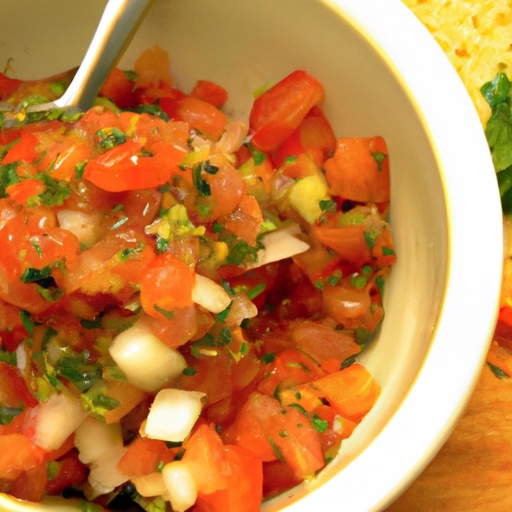Salsa
Description

Salsa is a vibrant and zesty condiment that has found its way into kitchens around the globe. This versatile mixture is typically composed of chopped tomatoes, onions, peppers, and a variety of seasonings and herbs. Its textures and flavors can vary widely, from smooth and mild to chunky and fiery. Salsa is not only a staple in Latin American and Mexican cuisines but has also been adapted by American and European cooks, integrating local ingredients and palates.
Common uses
Salsa is commonly used as a dip for tortilla chips, a topping for tacos and burritos, and a flavorful addition to grilled meats and vegetables. Its versatility extends to its incorporation in various breakfast dishes, such as huevos rancheros, and it can also serve as a base for more complex sauces and stews.
Nutritional value
Calories
A typical serving of salsa (about 2 tablespoons or 30 grams) contains approximately 10 calories.
Protein
Salsa generally contains less than 1 gram of protein per serving.
Fat
This condiment is typically low in fat, with less than 0.5 grams per serving.
Carbohydrates
Carbohydrates in salsa are mainly from the vegetables used, amounting to about 2-3 grams per serving.
Vitamins
Salsa is a good source of Vitamin C, especially when made with fresh tomatoes and peppers.
Minerals
It may also contain other minerals such as potassium, depending on the ingredients used.
Health benefits
Due to its low calorie and fat content, salsa can be a healthy addition to a diet. The tomatoes provide antioxidants like lycopene, while onions and garlic offer anti-inflammatory benefits. Spicy components like chili peppers can boost metabolism. However, the nutritional value may vary with homemade and store-bought versions, depending on the ingredients and additives used.
Potential risks
Store-bought salsas may contain high levels of sodium, which can be a concern for individuals with hypertension. Additionally, the acidity from tomatoes and other ingredients may cause discomfort for those with sensitive stomachs or acid reflux. Homemade salsas can mitigate these risks by allowing one to control the amount of salt and spices used.
Common recipes
Some common recipes that feature salsa include salsa fresca, pico de gallo, salsa verde, and fruit salsas. It is also used in the preparation of guacamole, enchiladas, and chilaquiles.
Cooking methods
Salsa can be prepared raw, cooked, or roasted, with each method bringing out different flavors and textures in the ingredients.
Pairing with other ingredients
Salsa pairs well with corn and flour tortillas, eggs, various cheeses, chicken, beef, seafood, and rice. It also works well with avocado and sour cream as a cooling counterpoint to its spice.
Summary
Salsa is a globally loved ingredient that enhances the taste of various dishes with its fresh, tangy, and sometimes spicy flavor profile. It can be made in numerous styles to complement a wide range of cuisines, making it a universal favorite in food recipes from around the world.